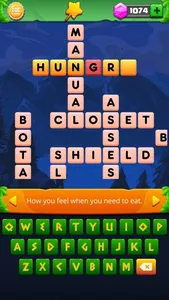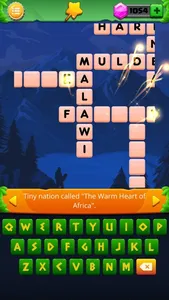"Crossword: Word Brain" is likely a game that challenges players to solve word puzzles by answering questions or clues. Here's a general overview of how such a game might work:
Gameplay Interface: The game will present you with a grid or a series of letters arranged in a specific layout, similar to a crossword puzzle or a word search grid. Each letter is typically placed in a separate tile or cell.
Clues and Questions: Alongside the grid, the game will provide you with clues or questions related to the words you need to find. These clues may be in the form of definitions, synonyms, antonyms, or other hints to help you identify the correct words.
Word Formation: Your objective is to connect the letters in the grid to form words that match the given clues or questions. You typically connect adjacent letters horizontally, vertically, and diagonally to create the words.
Word Validation: Once you connect a sequence of letters to form a word, the game will check if the word is correct by comparing it to the answer for the corresponding clue or question. Valid words are usually verified against a predefined wordlist or dictionary.
Points and Scoring: Successful word formations and correct answers are often rewarded with points. Some games may assign different values to individual letters or provide bonus points for finding longer or more challenging words.
Difficulty Levels: Word puzzle games often have multiple difficulty levels or stages. As you progress, the puzzles may become more challenging, requiring you to solve more complex clues or find longer words.
Hints and Power-Ups: To assist players, word puzzle games may provide hints or power-ups. Hints can give additional clues or reveal letters in the correct word. Power-ups might include tools to remove incorrect letters, shuffle the grid, or gain extra points.
Progression and Unlockables: As you successfully solve puzzles or answer questions, you may unlock additional levels, categories, or game modes. This allows for a sense of progression and provides access to new challenges or content.
Gameplay Interface: The game will present you with a grid or a series of letters arranged in a specific layout, similar to a crossword puzzle or a word search grid. Each letter is typically placed in a separate tile or cell.
Clues and Questions: Alongside the grid, the game will provide you with clues or questions related to the words you need to find. These clues may be in the form of definitions, synonyms, antonyms, or other hints to help you identify the correct words.
Word Formation: Your objective is to connect the letters in the grid to form words that match the given clues or questions. You typically connect adjacent letters horizontally, vertically, and diagonally to create the words.
Word Validation: Once you connect a sequence of letters to form a word, the game will check if the word is correct by comparing it to the answer for the corresponding clue or question. Valid words are usually verified against a predefined wordlist or dictionary.
Points and Scoring: Successful word formations and correct answers are often rewarded with points. Some games may assign different values to individual letters or provide bonus points for finding longer or more challenging words.
Difficulty Levels: Word puzzle games often have multiple difficulty levels or stages. As you progress, the puzzles may become more challenging, requiring you to solve more complex clues or find longer words.
Hints and Power-Ups: To assist players, word puzzle games may provide hints or power-ups. Hints can give additional clues or reveal letters in the correct word. Power-ups might include tools to remove incorrect letters, shuffle the grid, or gain extra points.
Progression and Unlockables: As you successfully solve puzzles or answer questions, you may unlock additional levels, categories, or game modes. This allows for a sense of progression and provides access to new challenges or content.
Show More









